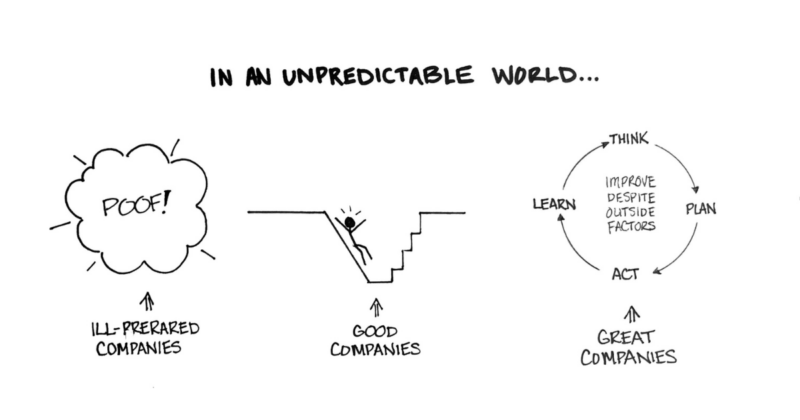LEADERSHIP
How To Get Predictable Results in Your Family Business in an Unpredictable World

“Bad companies are destroyed by crisis.
Good companies survive them.
Great companies are improved by them.”
This quote is from Andy Grove, the visionary leader and past CEO of Intel.
If you read between the lines, there are lessons to be learned.
It’s not the tumultuous and unpredictable times themselves that undermine companies. Businesses falter because they get complacent and/or they assume they will be immune to a downturn in the market, a supply chain disruption, or a talent shortage… to name a few.
The 3 different categories in Andy’s quote are defined by the business’ overall health the day BEFORE the uncertainty. Bottomline: Two of the three didn’t prepare.
And if COVID taught us anything, it is this: bad things happen, and they will happen again.
I’d like to reframe Grove’s “bad” companies differently. They aren’t inherently bad people with bad products. Instead, let’s rename them ill-prepared. From leadership principles to organizational health, from internal processes to product innovation, from hiring practices to vendor relationships, companies get destroyed because they failed to create the structure, systems, and discipline needed to grow long-term, in good times AND bad.
Without being committed to developing generations of leaders…
Without being grounded in its core values and core purpose…
Without being inspired and aligned around a compelling vision…
Without being disciplined to stay the course…
Without the awareness and agility to adjust as market forces dictate…
Family businesses will fail in times of turmoil and unpredictability.
Why do great family businesses improve despite dealing with the same crappy external factors that destroy some businesses and stall others?
Because they practice and execute these tenets:
- Right people doing the right things
- Learning is a daily occurrence
- The culture continuously develops leaders
- Communication is valued
- Organizationally health supports debate on tough issues
- Company values and core purpose drive decisions
- A compelling vision and strategy keep everyone aligned
- Discipline and accountability are the norm, not the exception
- The business can build and maintain a unique competitive advantage
- The team WORKS the plan
- The leadership recalibrates the plan annually
- Owners understand what they want out of the business and communicate it to the executive team
- Clear rules exist on how the family, owners, and the business interact with one another
Great companies follow the mantra of think, plan, act and learn.
The goal is to build a business model that produces predictable and repeatable results. And they do it in an unpredictable world. Don’t weasel out by telling yourself “my industry (my company, this product, etc…) is different than all the rest, and generating predictable results isn’t possible.” That’s just a cop-out. Do the hard work. Develop the discipline. As Thomas Edison so aptly stated, “Opportunity is missed by most people because it is dressed in overalls and looks like work.”
What NOT to do is as important as what to do.
Good companies typically watch growth slow or stall because they avoid or miss doing the things they need to do in order to be ready to improve and even thrive in uncertain times.
Perhaps they get stuck in thinking the things that initially made them successful will be the same things that will help them thrive the ebb and flow of the marketplace. Nope, think again. People change. Times change. Markets change. Plans need to change with them.
Or maybe there was no transition plan to ensure the heir apparent CEO was the best choice to lead the family business. Having the same last name as the marque signage on the building does not equal best. Leadership requires a different skill set than ownership.
Be honest with yourself and ask which of Andy’s categories your family business falls into right now – Ill-prepared, Good or Great?
When you review the bulleted list above, what’s the first next step you need to take to build an enduring family business? Not all the steps, just the NEXT step. Remember… it’s progress, not perfection.
It’s amazing how a little discipline over the long haul can produce predictable results – even in the unpredictable world we live in.
You may also like…

BLOG | FAMILY DYNAMICS / GOVERNANCE
The 4-Letter Word Owners Can’t Afford NOT to Talk About: EXIT
I’ve had my share of family business owners who avoid discussing this four-letter word to the point of pure denial, quickly ending the conversation when this word bubbles up. The word? E-X-I-T. It sounds so final. The brutal truth is that 100% of owners exit the business, yet only 50% – just 1 out of 2 owners – will do it on their terms...
Read More
BLOG | LEADERSHIP
Family Business Peer Groups are Gamechangers for the Next Gen
Many family-led companies hire business consultants to grow the business. Some even send their emerging leaders to personal development programs. But there is a gap – and it’s a BIG one.
Read More
BLOG | PEOPLE / TALENT
Unlocking the Golden 5% in Your Employees
The Golden 5% is the full expression of our ability, multiplied by our maximum possible effort, multiplied by our full contribution of heart. It is the performance equivalent of what we offer in a deeply loving relationship – the absolute best of ourselves. And yet, we rarely give it or reliably inspire the giving of it by others in organizations. Why?
Read MoreWhere Family Businesses Come to Grow & Learn
At Compass Point, we make it easy to get insights, training, tools, and articles straight to your inbox and help family business owners and their team continue to grow, learn, and lead.


